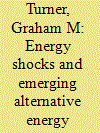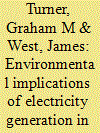|
|
|
Sort Order |
|
|
|
Items / Page
|
|
|
|
|
|
|
| Srl | Item |
| 1 |
ID:
116812


|
|
|
|
|
| Publication |
2012.
|
| Summary/Abstract |
Since the availability of cheap and suitable energy underpins in many ways both developed and developing economies, it is crucial that national economies are prepared for potential energy shocks. Shocks may arise from physical constraints, such as a peak in the national and global production rate of oil, or from institutional constraints, such as economic incentives to reduce greenhouse gas emissions. This article reviews the potential and implications of alternative energy technologies intended to avoid or alleviate such shocks. It is suggested that system-wide analysis is required to properly assess all alternatives.
|
|
|
|
|
|
|
|
|
|
|
|
|
|
|
|
| 2 |
ID:
111339


|
|
|
|
|
| Publication |
2012.
|
| Summary/Abstract |
Long-term, integrated modelling of electricity generation capacity and its operational requirements is important for coherent energy policy because of the multi-decadal lifespan of such plant, and because related fuel requirements, water consumption, and greenhouse gas emissions impact other sectors. This paper describes a physical model of electricity generation designed for long-term simulations, including the reproduction of decades of historical data, and its application to key policy questions. The simulation uses a dynamic, physical input-output model for the basic material and energy industries, embedded in an economy-wide stocks and flows framework (SFF). The historical reproduction, illustrated for the state of Victoria, is based on integrating bottom-up technical data on physical processes as inputs, and validating output against top-down aggregate data. We show that while greenhouse gas emissions would decrease significantly with the aggressive introduction of cleaner generation technology, long-term reductions are difficult to maintain against ongoing growth in consumption. Additionally, our sensitivity analysis identifies the importance of rapid action due to the age structure of operating power stations. We also identify significant imposts of alternative power generation on land and water resources, though a business-as-usual scenario would impose greater losses of water resources.
|
|
|
|
|
|
|
|
|
|
|
|
|
|
|
|
| 3 |
ID:
118843


|
|
|
|
|
| Publication |
2013.
|
| Summary/Abstract |
We investigate the impacts on the biophysical economy, employment and environment of a transition scenario to an energy-efficient, 100% renewable electricity (RE) system by 2060, based on wind, solar and biomass technologies, and an introduction of electric vehicles. We employ a CSIRO process-based model of the physical activity of Australia's economy and environmental resources, the Australian Stocks and Flows Framework. The RE systems are assumed to be manufactured in Australia to identify possible employment benefits. In comparison with the business-as-usual (BAU) scenario, on a national scale, the RE scenario has much lower economy-wide net emissions, remaining below contemporary levels and becoming zero in the electricity sector by 2060. Compared with BAU, the RE scenario also has significantly lower industrial water use, somewhat higher materials use, slightly lower unemployment, lower net foreign debt (relative to a GDP proxy) and, resulting from the growth in electric vehicles, reduced oil imports. The GDP per capita growth, based on the physical stocks of capital and labour, is virtually the same in both scenarios. Hence, from the viewpoint of the biophysical economy, there are no major barriers to implementing policies to facilitate the transition to a 100% renewable electricity system for Australia.
|
|
|
|
|
|
|
|
|
|
|
|
|
|
|
|
|
|
|
|
|